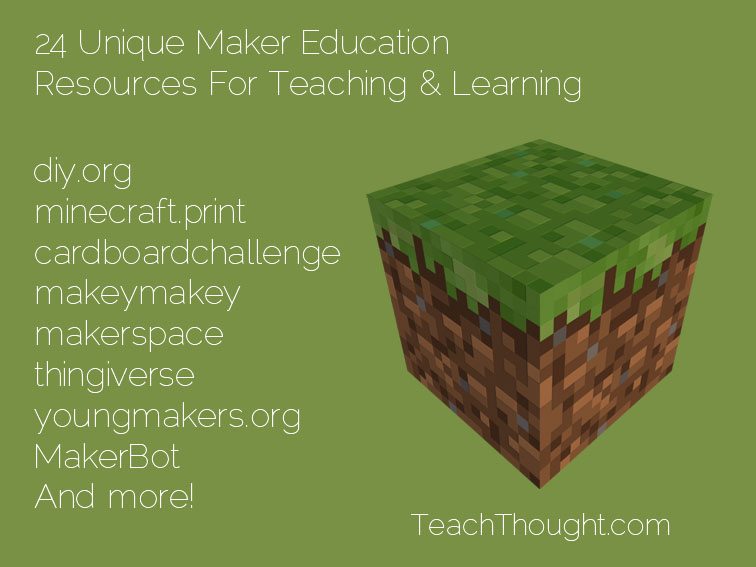
What Are Some Unique Maker Education Resources For Teaching & Learning?
by Mike Acedo
Makezine.com is a major hub for the maker’s movement, providing amateur makers and educators with a plethora of information, resources, and project ideas to implement for themselves, or in their classrooms.
2. http://www.raspberrypi.org/
This UK based tech company seeks to provide children of all ages and backgrounds with cheap, quality computers in hopes of educating kids in computer programming. For around 25$, educators can purchase a kit that includes the credit card sized computer, and simple how to assembly instructions. This allows kids to gain familiarity with how computers work, as well as how they are programmed.
The Maker Faire is an annual festival that takes place in multiple locations around the world, bringing together inventors, scientists, engineers, educators, tech enthusiasts, among other makers, to showcase innovation, learning, and celebrate the maker’s movement. It is a place where educators and parents can take their student’s to freely explore and learn from different makers and hopefully inspire them to tap into their own creativeness.
4. http://youngmakers.org/ & http://makered.org/
Both youngmakers.org and makered.org seek to bridge the gap between community involvement and the maker culture, providing kids, parents, and teachers with a community based infrastructure and resources that facilitate making. These institutions look to bring together like-minded individuals, mentors, and fabrication facilities to help kids bring to life their own project visions and share them in events like the Maker Faire.
5. http://www.instructables.com/index
Instructables is place where anyone can explore, learn, and share different creations and projects. It is a community of makers who openly share their projects to promote innovation and creativity, as well as provide educators and students with a place to develop project ideas and share their own creations.
6. http://makerspace.com
Makerspace allows new makers to create places to explore making, find the tools that will need, and provide access to a network of educators and members of the maker community. This enables individuals to share ideas and practices with other makerspace’s and connect with local community members who support the maker culture. It also serves as a way for makers and educators to network, as well as provides training and support to teachers who seek to enable making in their classrooms.
7. http://curriculum.makerbot.com/
MakerBot is a 3D printer outlet that provides affordable 3D printers as well as various project ideas and lesson plans, to educators and other makers. Their mission is promote and expand STEM learning and innovation by providing students with the tools necessary to bring their ideas to physical life.
8. http://www.thingiverse.com/
An offshoot of MakerBot, Thingiverse is a design community where others can discover, share and make 3D printable objects. It is a good resource for educators and students to find designs and share their own creations.
Adafruit is an online learning place where educators and makers can find articles, videos, tools and lessons that are centered on learning electronics.
10. http://web.media.mit.edu/~emme/guide.pdf
This manual is filled with various activities and experiments that teachers can take advantage of in order to facilitate interest in electronics, particularly, soft circuit experiments. These activities invite students aged 11-17, to explore technology through a creative context and a hands on approach.
11. https://learn.sparkfun.com/curriculum
Sparkfun.com provides makers and educators with the foundation and tools required for them to be successful in the electronic and tech world. The site provides beginner, intermediate, and advanced tutorials, presentations, code, and curriculum guides that cover a wide array of DIY education.
12. http://tinkering.exploratorium.edu/ & http://blogs.exploratorium.edu/tinkering/
The Tinker Studio is an interactive workshop located inside the Exploratorium museum in San Francisco, CA. It allows students to become engaged in science and technology through hands on experiments and being able to talk to featured scientists, educators, and staff. If educators are not able to take their students to the Exploratorium, the website provides several featured projects and instructions which can be done inside their classrooms.
13. https://diy.org/
DIY.org provides a vast selection of DIY instructional videos and lessons that span across multiple subject areas. The site also enables students to post and share their own creations, connect with others who have similar passions, and encourages students to test themselves by taking on various tasks and challenges. It is a great place for educators to find project ideas for their classes, and an exceptional platform for students to nurture their own creativity.
14. http://cardboardchallenge.com/
The Cardboard Challenge is an open-ended design challenge that encourages kids of all ages from around the world to design and build something out of cardboard and other recycled material. The building can take place anywhere from classrooms to backyards, as kids are encouraged to use their own imagination and creativity as their prime source of inspiration. Finally, a specific day is designated worldwide for the builders to take pictures of their creations and share them using social media. This is a great way for parents and teachers to encourage creativeness from their students and allow them to share it with others.
15. http://catalyst-academy.org/course/make-hack-play/
In this mini-course, educators are introduced to the “Maker Movement”, highlighting the benefits of it in digital and non-digital ways. It is a great opportunity for educators to become familiar with how the Maker Movement contributes to STEM education, and allows them to discuss and share their experiences with other educators.
The Business Innovation Factory has developed a project where students can use their own imagination and creativeness to develop their own lessons and have a direct influence on the way they learn. Included, is a Student Designer How-To Kit, which encourages students to take a direct roll in their own education and teaches skills that they can use outside of the classroom. Although this is not part of the typical Maker Movement, it allows teachers to give students the opportunity to exercise their own creativity by conceptualizing their own lesson design.
17. http://blog.nwp.org/clmooc/makes/
In this Making Learning Connected blog, various forms of connected learning are explored, including maker culture. The “Maker Bank” is a place where individuals share projects that they have made, allowing others to follow or contribute to them. This is a good place for educators and makers to research different maker projects and share their own.
18. http://makeymakey.com/
Makey Makey provides an invention kit where one can turn ordinary objects into touch pads that can be combined with computer programs and the Internet. This allows students and educators to creatively develop an infinite amount of projects and experiments that promote innovation.
Howtoons is a fun way to engage students in project based learning by using comic book style art and storytelling to teach kids how to build various STEM centered projects. Through its engaging art and instructional format, it is a valuable asset for educators to use in their classrooms.
20. http://stager.org/articles/goodpbl.pdf
Though these articles do not provide actual project ideas or designs, they do provide educators with guidance when constructing projects for their students. The articles highlight the key elements in designing a good project for students and give tips to educators that will help them develop projects that will facilitate creativity.
21. http://m2l.indiana.edu/
Make to Learn advocates the implementation of DIY and maker culture into the core of all educational practices. Make to Learn seeks to empower the maker community by connecting them with the resources needed for them to thrive and improve the educational outcome of the DIY movement. Through organized events, public outreach, and challenges on maker websites like Instructables.com, Make to Learn invites educators and makers to participate in and raise the overall awareness about the value of making in education.
Littlebits provides makers with a kit of tiny, interchangeable circuit boards, each with their own individual function, that allow makers to experiment in building sophisticated electronic projects. Littlebits also provides lessons and project ideas for students and educators to explore as they experiment with engineering and design.
23. http://glasslabgames.org/
Glass Lab Games use game based learning to facilitate creativity and digital design making. Through a Sim City based platform, students are given creative reign over a simulated city, where they can use their imagination to customize their city in an educational format. Though this is not a part of the traditional maker culture, it does facilitate creative design, and allows students to gain an understanding of real world issues that influence cities, as well as share with others their creative solutions to complex problems.
24. Minecraft.print
Print minecraft worlds using 3D printers. Incredible!
24 Unique Maker Education Resources For Teaching & Learning; image attribution flickr user flickeringbrad
